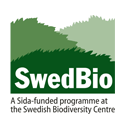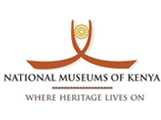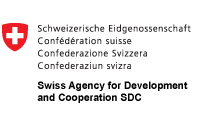Scientific Classification
Species in the Genus
Species in Kenya, Tanzania & Uganda
Description
Possible Causes of Confusion
Distribution in Kenya, Tanzania & Uganda
Habitats
Nesting
Crops Visited
Other Plants Visited
Economic / Ecological Importance
Threats
Conservation and Management Practices
Legislation (National and International)
References
Editors
Acknowledgements
Contact
Click on images to enlarge

Melitta haemorhoidalis. ©Bernhard Jacobi
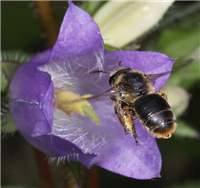
Melitta haemorhoidalis. ©Bernhard Jacobi
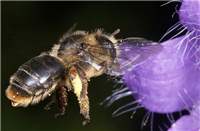
Melitta haemorhoidalis. ©Bernhard Jacobi

Melitta tricincta. ©Bernhard Jacobi
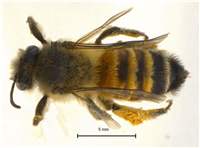
Melitta arrogans (female) - pinned specimen. Photo: Connal Eardley
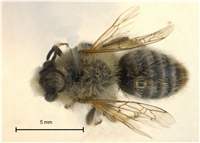
Melitta arrogans (male) - pinned specimen. Photo: Connal Eardley
Summary
Honey bees are not the only bee species that are significant for human wellbeing. Mellita bees are a group of native bee species that do not produce honey but are likely to be important pollinators of crops and wild plants. Mellita bees are not aggressive but can sting for defence. They have a mild sting that is much less painful than that of a honey bee. They are medium-sized (8 – 15 mm in length) hairy bees. Individuals nest in the ground in burrows and live independently of others (i.e. they are solitary). This fact sheet provides information about these bees to encourage farmers to understand and protect them to help ensure that their crops are effectively pollinated.
From a conservation and agricultural standpoint it is not necessary to recognise all the different bee genera. However, it is important to know that there is a large bee biodiversity. Different bee genera pollinate different plant species, although there is some overlap that acts as a buffer as bee populations wax and wane. For healthy ecosystems, including agro-ecosystems both diversity and abundance in the bee fauna is important.
Common Name (Language)
Melitta bees (English)
Scientific Classification
Kingdom: Animalia
Phylum: Arthropoda
Class: Insecta
Order: Hymenoptera
Family: Melittidae
Subfamily: Melittinae
Genus: Melitta Kirby, 1802
Species in the Genus
Melitta is a small genus of bees with about 40 known species, most of which have been recorded from
Species in Kenya, Tanzania & Uganda
There is little knowledge of these bees in Africa outside
Description
Melitta bees are not well known by local people (including farmers) in
Possible Causes of Confusion
Melitta bees are similar in appearance to other melittid bees. Non-experts may be unable to differentiate these bees.
Distribution in Kenya, Tanzania & Uganda
There is little information on their distribution in the region but this may be due to a lack of studies and not necessarily because of their absence from particular areas. Farmers can assist in reporting the presence of these bees in their neighbourhood. This would improve our knowledge of their distribution in the region.
Habitats
Melitta bees can be found in relatively undisturbed environments. The influence of altitude and climatic conditions on their distribution in
Nesting
Melitta bees are solitary species that nest in soil in burrows which they create.
Crops Visited
There is no substantial information on crops visited by Melitta bees
Other Plants Visited
There is no substantial information about the pollination ecology of these bees and hence the need to carry out research to acquire such information.
Economic / Ecological Importance
Little information exists on the usefulness of these bees to the lives of the people in
Threats
In
Conservation and Management Practices
There are now concerted research efforts in the region to develop best practices for conservation and management of bees to enhance crop production. Theoretically, bee conservation and management is inexpensive and adopted activities can also improve the aesthetic value of the landscape. Such practices involve setting land aside (e.g. a 1-metre strip) in the farmland to host all year round food resources for the bees, as well as safer sites for nesting, mating, resting and refuge from natural enemies. During flowering, farmers should manage pesticide usage carefully to avoid poisoning flower-visiting bees. Farmers should also minimise pesticide drift from the field to adjacent areas. Laws governing registration and use of plant protection products also indirectly play a major role in the protection of pollinators. Trampling by people and livestock and tilling should be managed to conserve the nesting sites of these species that nest in burrows. KARI (the Kenya Agricultural Research Institute) is developing protocols for mass rearing of different species of solitary bees. Any successful results from this research will be freely communicated to the public. In addition, KARI is collaborating with other stakeholders to ensure in situ conservation and management of bees for pollination purposes. Much of the work of conserving native bees will be underpinned by raising public awareness of the importance of these species.
Legislation (National and International)
There is not yet any legislation in
References
1. Eardley C and Kuhlmann M (2006) Southern and East African Melitta Kirby (Apoidea: Melittidae). African Entomology 14(2): 293–305
2. Eardley CD, Kuhlmann M and Pauly A. (2010) The Bee Genera and Subgenera of sub-Saharan
3. Eardley C, M Kuhlmann and Pauly A (2010) The Bee Genera and Subgenera of sub-Saharan
4. Eardley CD and Urban R (2010) Catalogue of Afrotropical bees (Hymenoptera: Apoidea: Apiformes). Zootaxa, 2455: 1–548.
5. Michener, CD (1974) The Social Behavior of the Bees,
6. Michener CD (2007) The Bees of the world, the John Hopkins University Press, Baltimore and London, pp 913.
Editors
Théodore Munyuli, Busitema University - Uganda; Muo Kasina, Kenya Agricultural Research Institute (KARI) - Kenya; Juma Lossini, Tropical Pesticides Research Institute (TPRI) – Tanzania; John Mauremootoo, BioNET-INTERNATIONAL Secretariat – UK; Connal Eardley, Plant Protection Research Institute (PPRI) – South Africa.
Acknowledgements
We recognise the support from the Kenya Agricultural Research Institute (KARI), Tropical Pesticide Research Institute (TPRI) –
Contact
BioNET-EAFRINET regional coordinator: [email protected]





